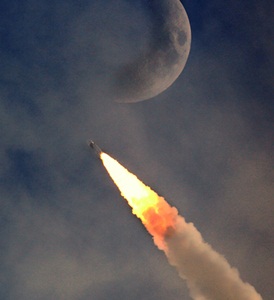The Indian Space Research Organisation (Isro) has called off an early morning launch of India’s second lunar mission, Chandrayaan-2, due to a technical snag, which will now be launched from the Satish Dhawan Space Center at Sriharikota on-board GSLV Mk-III sometime later.

“A technical snag was observed in the launch vehicle at T-56th minute. As a measure of abundant precaution, the Chandrayaan 2 launch has been called off for today,” said Isro in a tweet. A revised launch date will be announced later, it added.
Once launched, the spacecraft will be injected into an earth parking 170 x40400 km orbit. A series of maneuvers will be carried out to raise its orbit and put Chandrayaan-2 on Lunar Transfer Trajectory. On entering Moon's sphere of influence, on-board thrusters will slow down the spacecraft for Lunar Capture. The Orbit of Chandrayaan-2 around the moon will be circularised to 100x100 km orbit through a series of orbital maneuvers.
On the day of landing, the lander will separate from the Orbiter and then perform a series of complex maneuvers comprising rough braking and fine braking. Imaging of the landing site region prior to landing will be done for finding safe and hazard-free zones. The lander-Vikram will finally land near South Pole of the moon. Subsequently, Rover will roll out and carry out experiments on Lunar surface for a period of 1 Lunar day, which is equal to 14 Earth days.
The Orbiter will continue its mission for a duration of one year.
Chandrayaan 2 is planned to take India where no country has ever gone before — the Moon's south polar region. “The aim is to improve our understanding of the Moon — discoveries that will benefit India and humanity as a whole. These insights and experiences aim at a paradigm shift in how lunar expeditions are approached for years to come — propelling further voyages into the farthest frontiers,” an Isro release stated.
The Moon is the closest cosmic body at which space discovery can be attempted and documented. It is also a promising test bed to demonstrate technologies required for deep-space missions. “Chandrayaan 2 attempts to foster a new age of discovery, increase our understanding of space, stimulate the advancement of technology, promote global alliances, and inspire a future generation of explorers and scientists.”
Moon provides the best linkage to Earth’s early history. It offers an undisturbed historical record of the inner Solar system environment. Though there are a few mature models, the origin of Moon still needs further explanations. Extensive mapping of lunar surface to study variations in lunar surface composition is essential to trace back the origin and evolution of the Moon. Evidence for water molecules discovered by Chandrayaan-1, requires further studies on the extent of water molecule distribution on the surface, below the surface and in the tenuous lunar exosphere to address the origin of water on Moon.
The lunar South Pole is especially interesting because of the lunar surface area here that remains in shadow is much larger than that at the North Pole. There is a possibility of the presence of water in permanently shadowed areas around it. In addition, South Pole region has craters that are cold traps and contain a fossil record of the early Solar System.
Chandrayaan-2' is designed to hunt for deposits of Helium-3 — a waste-free nuclear energy that could answer many of Earth's energy problems.
The isotope of Helium, which is abundant on the moon, could theoretically meet global energy demand for three to five centuries, a Deccan Chronicle report said. This kind of energy is also expected to be worth trillions of dollars (one expert estimated Helium-3's value at about five billion US dollars a ton). There is approximately 1 million metric tons of Helium-3 embedded in the moon, the report said, although only about a quarter of that can realistically be brought to Earth.
Chandrayaan-2 will attempt to soft land the lander `Vikram' and rover `Pragyan' in a high plain between two craters, Manzinus C and Simpelius N, at a latitude of about 70° south.
Chandarayaan-2 has the distinction of being the:
- First space mission to attempt a soft landing on the Moon's south polar region;
- First Indian expedition to attempt a soft landing on the lunar surface with home-grown technology;
- First Indian mission to explore the lunar terrain with home-grown technology; and
- The fourth country ever to soft land.
The GSLV Mk-III is India's most powerful launcher to date, and has been completely designed and fabricated from within the country.
The Orbiter will observe the lunar surface and relay communication between Earth and Chandrayaan 2's Lander — Vikram.
The lander is designed to execute India's first soft landing on the lunar surface.
The rover is a 6-wheeled, AI-powered vehicle named Pragyan, which translates to 'wisdom' in Sanskrit.































